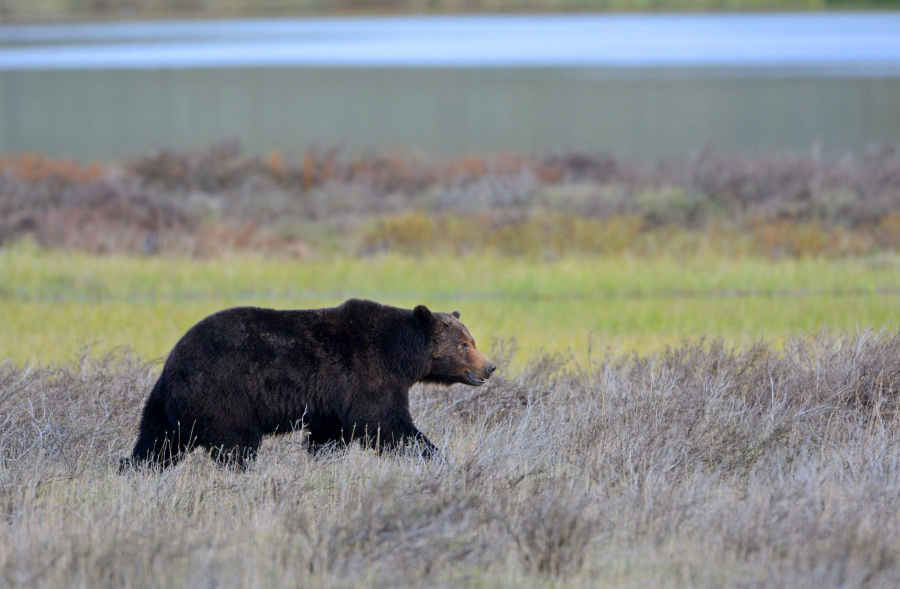Federal agencies again want your input on a proposal to bring grizzlies back to the deep forested valleys of the North Cascades that the big, brown bears once called home.
The National Park Service and U.S. Fish & Wildlife Service on Thursday published three options for the public to consider, with a goal of restoring a population of about 200 bears over the next century.
Grizzly bears roamed the North Cascades for thousands of years before humans hunted them to near-extinction. The bears were a critical part of the ecosystem, turning soil as they dug for roots, eating berries and distributing the seeds in their scat, and keeping small animal populations in check.
The last confirmed sighting of a grizzly bear in the U.S. portion of the North Cascades was in 1996, according to the National Park Service.
The remaining grizzlies in the Western U.S. are managed within six recovery zones. The North Cascades is one of two grizzly bear recovery areas without an established population of bears. Federal officials have determined it’s unlikely grizzly bears would move into the North Cascades without a relocation effort.
Under both reintroduction options outlined in the plan, about three to seven grizzly bears would be released into the North Cascades each year over the course of about five to 10 years. The goal is to establish an initial population of 25 grizzly bears.
One option outlined in the plan would allow grizzly bears to be managed as a threatened species under the Endangered Species Act, and only permit some to be captured, moved or killed under specific circumstances, like the defense of life and scientific or research activities.
The other reintroduction option would designate the bears as a nonessential experimental population and give agencies “greater management flexibility should conflict situations arise.”
The Fish & Wildlife Service is separately inviting the public’s input on this option, and what management strategies for grizzly bears might look like, if the option were selected.
Officials would identify and capture 2- to 5-year-old bears that had not reproduced and had no history of human conflict and release them in the North Cascades between June and September each year.
The federal agencies also offered the option of taking no action and instead relying on natural recovery.
Returning grizzlies to the North Cascades has been a nearly decadelong on-again, off-again effort.
In 2014, under the Obama administration, federal officials announced a grizzly recovery study. In mid-2017, officials from the U.S. Department of the Interior, without clear explanation, halted progress on the recovery efforts. The process kicked back into gear in 2019, but that effort was again squelched by Interior, under the Trump administration, in 2020.
It’s been a process lauded by environmental advocates and opposed by ranching groups and Republican lawmakers. In 2017, agencies received .
Last November, federal agencies published a notice of intent to restart a plan to restore grizzly bears to the North Cascades.
The North Cascades are among the largest wild areas in the contiguous 48 states, encompassing close to 10,000 square miles. Scientists identified the mountain range as prime habitat for grizzly bear reintroduction in 1997.
“The Upper Skagit people are historically the people of the North Cascades, along with the grizzly bear,” Scott Schuyler, policy representative for the Upper Skagit Tribe said in a phone call. “It has always been important for us to restore and see the return of grizzly bears.”
“From the tribe’s standpoint, we believe the answer is pretty clear: yes, they do have a right to exist,” he said. “Our history proves that coexistence is possible, our ancestors respected these animals and they thrived up until the point they were driven out.”
The public is invited to submit comments on the proposals through Nov. 13. The draft plan can be found at the National Park Service website under the 2022 North Cascades Ecosystem Grizzly Bear Restoration Plan/Environmental Impact Statement. Comments can also be submitted to: Office of the Superintendent, Grizzly Restoration EIS, 810 Highway 20, Sedro-Woolley, WA 98284.



